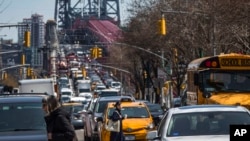Research shows that prolonged exposure to high levels of noise may be a risk factor for cardiovascular disease.
In New York City, not only the largest U.S. city by population but also one of the loudest, avoiding noise can be an everyday struggle.
Ricky Nguyen resides in the heart of New York City's Chinatown, where the cacophony generated by ongoing construction has drastically disrupted his daily life.
The relentless clamor has grown to such an extent that Nguyen now measures the noise that affects not only him but also the tightly knit community of older Asians who live on his block.
He said he had to buy a noise meter.
"I can’t imagine for the elderly that's living in that building over there, they have open windows and they're directly adjacent to all the noise,” Nguyen said. "I lived here for 11 years, and I wanted to live here for the next 11 years."
Recent research involving 130,000 people who used the noise detector feature on their Apple Watches has uncovered concerning results, as disclosed by the study's principal investigator.
Rick Neitzel, University of Michigan Environmental Health Sciences, said preliminary results suggest that potentially as many as one in three Americans are exposed to levels of sound that might be harmful to their health.
Neitzel's research also revealed other unexpected findings.
“We've also found that not everybody is equally exposed," he said. "In fact, our participants who are Black or Hispanic have tended to have higher noise exposures than folks from other racial and ethnic groups."
In a separate study, researchers at the Massachusetts General Hospital have correlated prolonged noise exposure to significant health issues, potentially leading to fatal outcomes.
“From our data and the work of others, it appears that noise has been under-recognized and independent risk factor for the development of cardiovascular disease,” said Dr. Michael Osborne, a cardiologist at the hospital and lead researcher of the noise study.
Osborne’s study also found that people living in areas with high levels of transportation noise, such as near airports, face an increased likelihood of major cardiac events.
“We found, basically, that there was a pathway linking noise to cardiovascular disease that came through the brain and involved inflammation of the arteries leading to this downstream consequence, it's likely an under-recognized risk factor for cardiovascular disease," he said.
In response to such health concerns, information about the hazards of noise pollution has expanded through websites, organizations, and apps that empower people to gather data and push for quieter neighborhoods.
Arline Bronzaft is an activist in the field of noise harm reduction.
“When I started, there were fewer people who were fighting for less pollution to now there are more people," she said. "There are more studies, and we've just had a congresswoman introduce legislation to re-fund the office of noise abatement and control at the EPA."
With the federal government potentially addressing this invisible menace, noise pollution may soon become as prominent a concern as air pollution.










